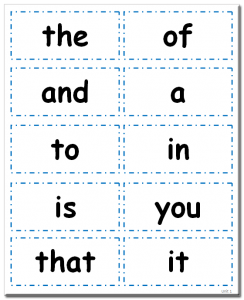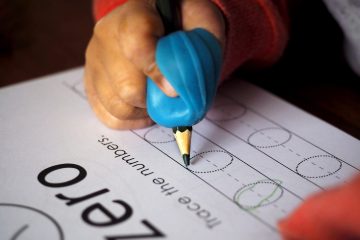 Ever wonder why your child’s teacher stresses the importance of practicing the words on those dreaded flash cards in Kindergarten and First Grade? Believe it or not, the top three hundred or so sight words make up about two-thirds of all written matter. Imagine, then, how much easier it will be for your child to read once she masters them!
Ever wonder why your child’s teacher stresses the importance of practicing the words on those dreaded flash cards in Kindergarten and First Grade? Believe it or not, the top three hundred or so sight words make up about two-thirds of all written matter. Imagine, then, how much easier it will be for your child to read once she masters them!
Reading words as whole words is what more advanced readers do when they read. As you read this post, you’re not taking the time to break down every individual word you read into its basic phonemes (if you did, reading one simple sentence might take all day!).
Advanced readers have enough practice with reading that almost all words are familiar, and are recognized as a whole unit. For example, when you see the word “family,” you do not have to sound out /f/ /a/ /m/ /i/ /l/ /y/, but rather your brain recognizes the word, associates it with its meaning, and places it within a logical context in the sentence. This enables you to read quickly, and that in turn ensures that you understand what you are reading.
Your child will also begin to identify whole words while learning how to read. For example, he or she will start to understand that the word “cat” is more than just the letters “c,” “a,” and “t,” put together, that it is just the whole word “cat,” and it will be associated with a small furry creature. Other whole words that your child may begin to identify are sight words.
Sight words, also called high frequency words, are the words that appear with the highest frequency in written text.
Some sight words, such as “at” and “an,” are phonetically regular and can be sounded out by beginning readers. Many of them, however, are not (for example “about” and “could”) and must therefore be recognized as whole words. Even if a sight word is phonetically regular, since it appears with such frequency in text it is better for the word to be read automatically. This will speed up the reading process for a beginning reader, leading to greater fluency and stronger comprehension.
There are several compiled lists of the highest frequency words. Probably the most well-known sight word lists are Fry’s 1000 Instant Words and Dolch Word Lists. These lists detail the words that beginning readers should learn to instantly identify when reading. Over half of all written material is comprised of the first 300 words on Fry’s Word list, so familiarity with these words is understandably an essential component of reading.
There are many ways in which you can give your child practice with identifying sight words and other whole words:
- Expand your Letter Wall into a Word Wall: Prominently place sight words, especially phonetically irregular words like “from” and “or,” on a magnetic surface, whiteboard, bulletin board or other area. As your child becomes familiar with other new words, include them on your word wall.
- Word Games: Play word games such as Bingo and Memory, which involve whole word recognition.
- Flash cards: Give your child extra practice with sight words by running through sight word flash cards.
- Writing Activities: Offer your child the opportunity to begin writing known words. Practice with encoding familiar words will help his familiarity with new words.
- Sight Words in Text: Pause to point out sight words when reading with your child.
- Playing Online Learning Games: The first level of Red Apple Reading, for example, teaches the first 100 words from Fry’s word list, in combination with beginning phonics skills.
K12 Reader has some more ideas if you are interested. And Pinterest fans can find a huge number of ideas by typing “sight words” into the Search feature.
The more you vary the learning and spend time working on sight words, the more quickly your child will learn and remember them. So take those words the Kindergarten teacher sent home and have some fun with them!
Do you have any great ideas to share that worked for you? Please share them with us below.


